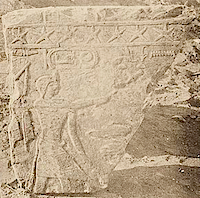Pepi II is traditionally listed as the last ruler of Egypt’s Sixth Dynasty, and the last significant ruler of the Old Kingdom before the First Intermediate Period. He was only 6 years old when he began his incredible 90-year rule (making his the longest reign in Egyptian history). Some scholars have raised doubts about the dates, as it was not common to live so long, but it is recorded that he was 100 years old when he died! It is thought that his mother Ankhesenpepi II (widow of Pepi I) acted as regent for a period at the beginning of his reign.

He had a number of wives, including Neith (the daughter of Pepi I) and Ankhesenpepi III and Iput II (the daughters of his brother Merenre I) and Ankhesenpepi IV (the mother of one of the kings named Neferkare, but we don’t know which one), and Udjebten (thought to be another daughter of Pepi I). He probably had a son named Merenre who may well be the Merenre II of the kings list.
Foreign policy (especially in Nubia) had become quite a drain on resources. The well oiled Egyptian bureaucracy began to disintegrate and some diplomatic relations were suspended. Scenes showing Pepi II smiting Egypt’s foes are thought to be purely ritualistic. For example, a frieze showing the submission of Libyan chiefs during his reign is suspiciously similar to the scene in the mortuary temple of Sahure, while other scenes are reminiscent of those in the mortuary temples of Niuserre and Pepi I

His long reign may have created successional difficulties, and some have argued that the low quality of the inundations at the end of the sixth dynasty was causing crop failure and famine. However, there is significant evidence that the power and wealth of the nobles was increasing at that time. Elaborate tombs were built at Cause, Akhmin, Abydos, Edfu, and Elephantine. As the nobles held hereditary positions, and were now independently wealthy, their loyalty to the king was perhaps reduced.
In a move to increase his control over the regions, Pepi II split the role of Vizier into two posts, one for Upper Egypt, the other for Lower Egypt.
Pepi II is depicted in a beautiful calcite statuette of the young king and his mother, Ankhesenpepi II. He is also recorded in a number of decrees and inscriptions at Abydos, Koptos (Coptos), and Iput. We also have a record of one of his Heb Sed festivals (jubilee) and the pharaoh is mentioned in the tombs of Djau (buried in Abydos) and Ibi (buried in Deir el-Gabrawi).
It is also possible that Pepi II is the king referred to in the “tale of King Neferkare and General Sasenet” which recounts the clandestine meetings of a king and one of his generals with whom he was possibly having a homosexual relationship. The tale only exists in fragments, and its meaning is still debated.
He built a ka-chapel in Abydos and located his pyramid and mortuary complex in South Saqqara. Most of his wives were buried in smaller pyramids nearby.
Pharaoh’s Names
Manetho; Phiops
Horus Name
Hr nTr haw (Horus Netjerikhaw) – Horus Divine Of Apparition
Nebti Name
nbti nTr haw (Nebti Netjerikhaw) – The Two Ladies, Divine Of Apparition
Golden Horus Name
sxm bik nbw (Sekhem Bik-Nebu) – The Golden Falcon Is Powerful
Prenomen
nfr kA ra (Neferkare) – Beautiful Is The Soul Of Re (Abydos kings list and Saqqara kings list)
Nomen
ppy (Pepi)
sA ra ppy (Sa Re Pepi) – Pepi Son Of Re
sA ra ppy nfr kA ra (Sa Re Pepi Neferkare) – Pepi Son Of Re, Ka Of Re Is Beautiful
Bibliography
- Bard, Kathryn (2008) An introduction to the Archaeology of Ancient Egypt
- Bourriau, J (2000) “The Second Intermediate Period”, in The Oxford History of Ancient Egypt Ed I. Shaw
- Dodson, A and Hilton, D. (2004) The Complete Royal Families of Ancient Egypt
- Hornung E (1999) History of Ancient Egypt
- Kemp, Barry J (1991) Ancient Egypt: Anatomy of a Civilisation
- Malek, Jaromir (2000) “The Old Kingdom”, in The Oxford History of Ancient Egypt Ed I. Shaw
- Rice, Michael (1999) Who’s Who in Ancient Egypt
- Wilkinson, Toby (2010) The Rise and Fall of Ancient Egypt
Copyright J Hill 2008